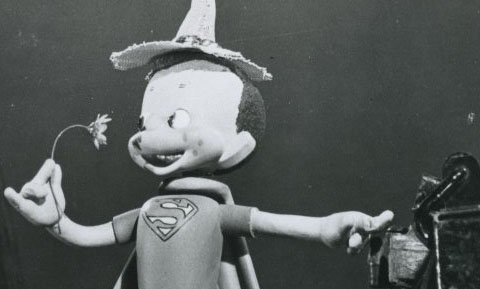

Cartoon Brew TV #18: Superman’s Secret Cartoon History
This week we open the Brew Vaults to examine the various ways the world’s first super-hero was animated, portrayed and even lampooned in the years between his comic book inception (1938) and prior to the iconic live-action TV show of the 1950s.
Jerry Beck first provides a running audio commentary over scenes from the classic Max Fleischer Superman cartoons, then uses rare film clips to trace how the character was interpreted by other Hollywood animators–some authorized, others unauthorized.
Superman was one of the most famous American creations of the 20th Century. The first true comic book super-star and a cultural icon, the caped character quickly leapt from ten cent comic books to daily newspaper stardom and a popular radio show. Then Hollywood called. Republic Pictures tried to license him for a twelve chapter serial, but Paramount placed a higher bid and the Man of Steel became a cartoon pioneer–the first science fiction adventure cartoon, setting the bar for all action animation to come.
Naturally, Warner Bros. was the first studio to spoof Superman. Bob Clampett painted him as a buffoon in Goofy Groceries (released March 29th 1941), a Merrie Melodies cartoon. Terrytoons came up with a parody, casting our superhero as a mouse in The Mouse of Tomorrow (1942). This proved so popular several sequels were produced, leading to a full-fledged series of Mighty Mouse cartoons. Chuck Jones kidded the Superman legend using Bugs Bunny as his Super Rabbit (Warner Bros.) in 1943.
Paramount, the studio who paid handsomely for the rights to Superman, used the character in trio of animated shorts after the 17 Fleischer/Famous Studio masterpieces. First, they created a classic Popeye cartoon, She Sick Sailors (1944), which cast a star struck Olive Oyl, smitten with the Man of Steel, as the object of affection between her rival Supermen, Popeye and Bluto. Next they allowed George Pal to use the famed red & blue costume and shield in a Puppetoon short–A Hatful Of Dreams (1945)–as little Punchy dreams himself as Superman to win the heart of beautiful Judy. Finally, a strange combination of two comic strip legends, as Little Lulu defeats a fairy tale giant as Super Lulu (1947), a cartoon directed by the legendary Bill Tytla.
In 1948, Superman was personified in a weekly live action movie serial by actor Kirk Alyn. The Sam Katzman chapterplays (Superman in 1948, Atom Man Vs. Superman in 1950) were produced on the cheap. Unable to come up with a low cost way to make his actor fly, Katzman turned to cartoon animation. Director Howard Swift (Fantasia) set up his own commercial animation studio shortly after the Screen Gems studio shut down (Swift was a director there) and was brought in to add several shots of Superman in flight. You decide whether he succeeded or not; it didn’t fool any of the kids in the audience.
These odds & ends of super-minutiae from the 1940s reflect the fame and popularity of the character’s early years. Superman has been a TV hero, a movie star and a staple of animation programming almost continuously since his creation, as this episode from the Brew Vaults aptly demonstrates.
(Thanks to Steve Stanchfield for recording the commentary track, and Randall Kaplan for sound and picture editing.)
